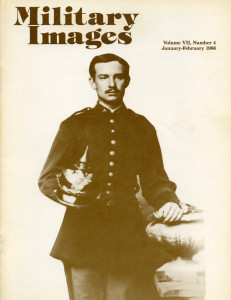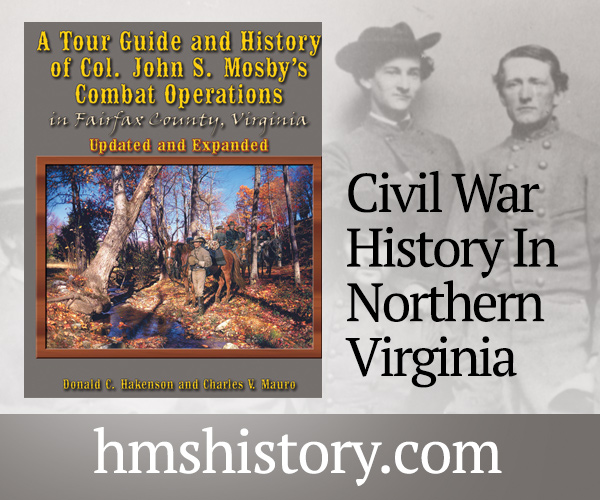The complete issue
Vol. VII, No. 4
(32 pages)
Print edition: Visit our store to check availability
Digital edition: Visit JSTOR.org to purchase
Subscribe to MI
Explore the MI Archives: Browse | Advanced search | Tutorial
Inside
Cover image
He may look like a Prussian soldier fresh from a victory in the Franco-Prussian War, but the soldier on the cover with the Pickelhaube helmet is Joseph Vance, a member of Company A, Light Artillery, Rhode Island State Militia, taken 1885-1886.
Editor’s Desk (p. 1)
The editor presents two new features with this issue. “The Darkroom” answers reader questions about the technology of imaging, while “Exhibits” lists museum and traveling exhibitions of interest to the readership. He also describes the types of articles that will be forthcoming, and welcomes suggestions as well as images. The editor also reprinted a clearer version of the wounded soldier in his hospital gown from the previous issue’s “Stragglers” feature.
Mail Call (pp. 2-3)
Letters to the editor included a request for help in identifying a shoulder strap uniform device, additional information on images from past issues, and additional responses to the editorial regarding U.S. policy in Nicaragua.
Darkroom (pp. 4-5)
George Hart’s first feature responds to the question regarding the sizes of different types of images. While a standard table is presented in the response, the great variation in sizes such as quarter-plate or ninth-plate images is due to the fact that many photographers cut their own plates. Tintypes are particularly known for this.
Six Sons for the Confederacy: The letters of Robert H. Jones, 22nd Georgia Infantry edited by Keith Bohannon (pp. 6-8)
The eldest of the six Jones brothers from Floyd County, Georgia, Robert H. Jones had organized the “Fireside Defenders” in August 1861. Once organized into the 22nd Georgia Volunteers, the 33 year old Jones was made colonel, two brothers made captain, one chaplain, and two remained privates. All six appear in an image taken in 1861, and although the six fought together at the start of the war, none were still with the 22nd Georgia at war’s end. The letters from Colonel Jones to his wife Lucinthia provide a glimpse into camp life during several different points of the war, from the humorous response of his troops (and body servant) to hearing cannon fire that was not warfare, but a salute to George Washington on his birthday to a more serious account of his unit during the Seven Days. Writing from Leesburg, Virginia, he tells her that “all the Brothers are well” just days prior to Antietam, where his brother Captain Wesley Jones was wounded; taken prisoner, he died from his wounds in October 1862.
“It is with a heavy harte…”: A letter to Private Clark’s sister edited by Richard K. Tibbals (p. 9)
Both men were 24 years old, and both enlisted in Company H, 22nd Indiana Infantry, Post’s Brigade from their homes in Lexington, Indiana. Privates John Clark and John Snodgrass had been friends at home, and remained close in their military lives as well. However, at Stone’s River on December 31, 1862, the fighting between the Union forces and their Confederate attackers split the two. In a letter sent to Private Clark’s sister Margaret, Private John Snodgrass wrote about the fighting that day, how he stayed with his friend as long as he could, and that he had been properly buried in a walnut coffin.
Farewell to Fancy Epaulettes: Philadelphia militia uniforms, 1866-1917 by Philip Katcher (pp. 10-13)
Eight different images accompany this article that describes the many changes seen by the militia of Philadelphia. Focusing on the last three to wear independent volunteer uniforms, the author briefly discusses the histories of the First Troop, Philadelphia Cavalry, the State Fencibles of Philadelphia, and the First Regiment Infantry of Philadelphia and their glorious dress uniforms.
Vignette: A Late Paycheck for Gilbert Montgomery, 4th U.S. Cavalry by William Gladstone (pp. 14-15)
A bit of sleuthing partially answers the questions about the man in the image and the two documents that belonged to him that are the focus of this article. A cook, not a soldier, Gilbert Montgomery was subject to the same procedures as enlisted soldiers. But there was a problem when Gilbert Montgomery was discharged from his five year service in 1869: he was underpaid. He was sent a check to make up the difference, and that check was not cashed. The question remains of why he never took the check to recover the $21.17 he was owed for his service.
Victorian Warriors: A photo survey of uniforms of the National Guard, 1870-1890 by Anthony Gero (pp. 16-24)
Sixteen images accompany the short article that outlines the history of the National Guard in the post-Civil War era. The increased cost of these units combined with a decrease in recruitment during this era led to many states standardizing their National Guard uniforms along federal lines. By the time of the Spanish-American War in 1898, only a few places retained the marvelous Victorian uniforms shown in this article. Featured are bearskins, several M1881 helmets with Prussian-style Pickelhaube, shakos, kepis with plumes, tailed coats, and epaulettes.
Vignette: A Down East Heavy: Rodolphus Tufts, 1st Maine Heavy Artillery by Wendell W. Lang (p. 25)
Enlisting in Company D, 18th Maine Infantry, Rodolphus Tufts was sent with his unit to be part of the permanent defense of Washington in August 1862. In the following January, the unit was reorganized into the 1st Maine Heavy Artillery, and expected to remain in their defensive post. In May 1864, following the fighting in the Wilderness, General Grant ordered the “heavies” to reinforce his Army of the Potomac. On June 18, the 1st Maine Heavy Artillery underwent the heaviest loss of a single unit in a single battle: 242 killed, 372 wounded, and 1 missing out of 900 men total. Tufts and the other surviving members of the unit eventually became involved in the more quiet game of siege warfare in the trenches around Petersburg. He was killed in a small skirmish on October 2, 1864 on Squirrel Level Road and buried as an Unknown in Poplar Grove National Cemetery.
Vignette: A Tarheel for the Union: Hugh Hamilton, 2nd North Carolina Mounted Infantry by John Sickles (p. 27)
The confident soldier in the image walked from him home in Buncombe County, North Carolina through the Cumberland Gap shortly after it was captured by De Courcy’s Union forces in September 1863. Hugh Hamilton was a Unionist and enlisted in Company B of the 2nd North Carolina Mounted Infantry. Other Tarheel Unionists and “Galvanized Yankees” (Confederates who had been captured, taken the oath of allegiance to the United States, and enlisted to fight) made up the unit. On February 22, 1864, at Wireman’s Mill, Virginia, Hugh Hamilton was captured, although he was initially listed as a deserter for reasons that remain unclear. He was sent to prison camp at Belle Isle in Richmond, where he became ill with bronchitis and hepatitis; he was exchanged and sent to a Union hospital in Annapolis. Eventually recovering most of his health, he was transferred to the Veteran Reserve Corps in Baltimore. He married there, and eventually returned to North Carolina after the war.
Passing in Review (pp. 28-29)
Six different publications are presented for review in this issues of Military Images. First is The Congressional Medal of Honor: the Names, the Deeds tells the story of the Medal and those who have been awarded it. September Blood: the Battle of Carnifex Ferry by Terry Lowry, who provides a regional history of the fight for Western Virginia at the start of the Civil War. Uniforms of the American Civil War by Philip Haythornthwaite was deemed to be a disappointment by the reviewer. While some errors were seen as small, the implication that the battleflag of the Army of Northern Virginia was used by all Confederate armies was a major flaw. Battle at Balls Bluff by Kim Bernard Holein was reviewed as a comprehensive work that describes the battle, the participants, its significance, relics and period items, and a case study of how preservationists, collectors, and others can work to preserve a historic site. Twenty Million Yankees by Donald Jackson and the editors of Time-Life Books is a volume in the Civil War series of books, and looks at the impact that the Civil War had on everyday life in the North and how those changes led to lasting impact on the Northern economy. Lastly, Great Civil War Heroes and Their Battles was edited by Walton Rawls, and provides an excellent look at the nostalgic publications found in cigarette cards and other sources published in the latter part of the 19th century.
Stragglers (pp. 30-31)
Two different sets of images are presented as “Stragglers” in this issue. The first is of Sergeant Herman L. Small of Company C, 6th Vermont Infantry. Two are portraits of the soldier, who enlisted as a private in October 1861 and left the service as a second lieutenant. His kepi is of particular interest and merited a close-up shot, as it has many non-regulation features attached to it. The other set of images consists of six cartes de visite that provide humorous views of Federal generals and one admiral such as “Little Mac” and “Uncle Sam’s Admirable Porter” in caricature form.
Back Image
A stirring portrait of a Union infantry soldier wearing his full pack (and white gloves). He strikes the pose he would take when preparing for a cavalry advance.





































